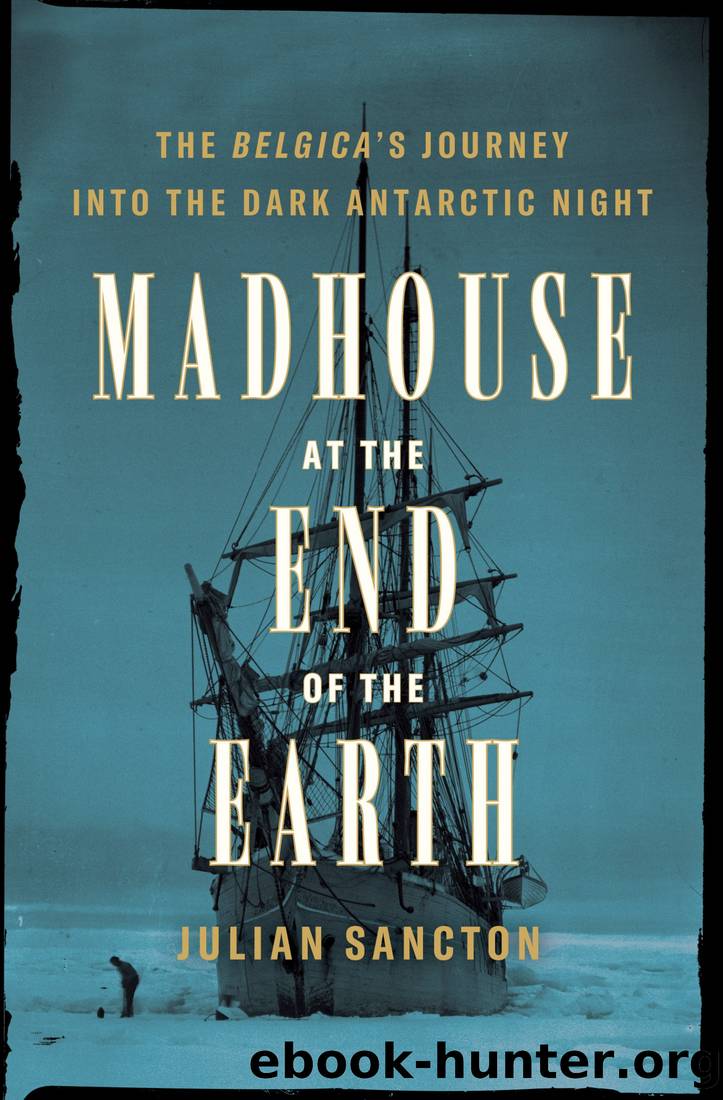Madhouse at the End of the Earth by Julian Sancton

Author:Julian Sancton [Sancton, Julian]
Language: eng
Format: epub
Published: 2021-05-04T00:00:00+00:00
* * *
â
On the clear and frigid evening of June 3, Cook left the ship with his camera and tripod on his shoulder and walked about a hundred yards across the pack under a dazzlingly bright moon. By its light, even the most distant icebergs stuck out neatly from the horizon. The doctor cut through a maze of hummocks and ridges caused by the previous weekâs pressures. He planted the tripod in the ice, turned his camera toward the Belgica, and opened the shutter. A spectacular image filtered through the Zeiss lens and began to impress itself on the light-sensitive silver salt emulsion that coated the cameraâs glass plate.
Cook paced vigorously to keep warm, unable to return to the ship lest his movement ruin the exposure. A self-taught photographer, he wasnât sure how long to wait; all he knew was that the ship had never looked more beautiful and there would likely never be a better chance to capture her at night. As fear and anxiety took hold of the Belgica, Cookâs curiosity and passion for polar work were undiminished. It was as if he could fly at will above the concerns of the pack, much like a cartoon Racovitza had drawn, depicting the doctor as a winged, angel-like savior.
After an hour and a half, Cook delicately closed the shutter, hurried back aboard, and stomped the snow off his boots. Impatient to see the photograph, he walked through de Gerlacheâs cabin and into the darkroom. In the chamberâs dim red glow, Cook plunged the clear glass plate into a vat of developer. The specter of a ship gradually appeared as the exposed silver salts darkened in the chemical bath. When he was satisfied with the image, he dropped the plate into acetic acid to stop the development process. Next, he would fix it, eliminate all remnants of silver salts, and render the negative impervious to light. During this step, he moved slowly and tried not to breathe, aware that the slightest false movement could prove deadly. Having used up all of the sodium thiosulfateâa fixer commonly known as hypoâin the early part of the voyage, when he was still getting used to his equipment and to the subtleties of photographing in polar light, the doctor had improvised a solution. He had read in an old issue of a British magazine lying around the ship that hydrocyanic acid, an extremely toxic poison, was once used as a fixer for daguerreotypes. Conveniently, Racovitza had brought twenty gallons of it on board to kill animals for specimens. (âOne drop on the tongue,â Cook wrote, âand it was all over for the animal.â) After experimenting with various dilutions, Cook had found a formula that did the trick. He poured a bath of the stuff, which smelled faintly of almonds, and daintily submerged the negative plate. âNeedless to say,â Cook wrote, ânobody remained in the darkroom during fixing.â The poisonous fumes eventually escaped the unventilated darkroom through the door to de Gerlacheâs cabin.
Once the cyanide was washed away, Cook could finally contemplate his work in unfiltered light.
Download
This site does not store any files on its server. We only index and link to content provided by other sites. Please contact the content providers to delete copyright contents if any and email us, we'll remove relevant links or contents immediately.
| Africa | Americas |
| Arctic & Antarctica | Asia |
| Australia & Oceania | Europe |
| Middle East | Russia |
| United States | World |
| Ancient Civilizations | Military |
| Historical Study & Educational Resources |
The Dawn of Everything by David Graeber & David Wengrow(1632)
The Bomber Mafia by Malcolm Gladwell(1568)
Facing the Mountain by Daniel James Brown(1493)
Submerged Prehistory by Benjamin Jonathan; & Clive Bonsall & Catriona Pickard & Anders Fischer(1409)
Wandering in Strange Lands by Morgan Jerkins(1359)
Tip Top by Bill James(1341)
Driving While Brown: Sheriff Joe Arpaio Versus the Latino Resistance by Terry Greene Sterling & Jude Joffe-Block(1327)
Evil Geniuses: The Unmaking of America: A Recent History by Kurt Andersen(1303)
Red Roulette : An Insider's Story of Wealth, Power, Corruption, and Vengeance in Today's China (9781982156176) by Shum Desmond(1299)
The Way of Fire and Ice: The Living Tradition of Norse Paganism by Ryan Smith(1293)
American Kompromat by Craig Unger(1256)
It Was All a Lie by Stuart Stevens;(1243)
F*cking History by The Captain(1231)
American Dreams by Unknown(1214)
Evil Geniuses by Kurt Andersen(1211)
Treasure Islands: Tax Havens and the Men who Stole the World by Nicholas Shaxson(1205)
White House Inc. by Dan Alexander(1161)
The First Conspiracy by Brad Meltzer & Josh Mensch(1124)
The Fifteen Biggest Lies about the Economy: And Everything Else the Right Doesn't Want You to Know about Taxes, Jobs, and Corporate America by Joshua Holland(1073)
